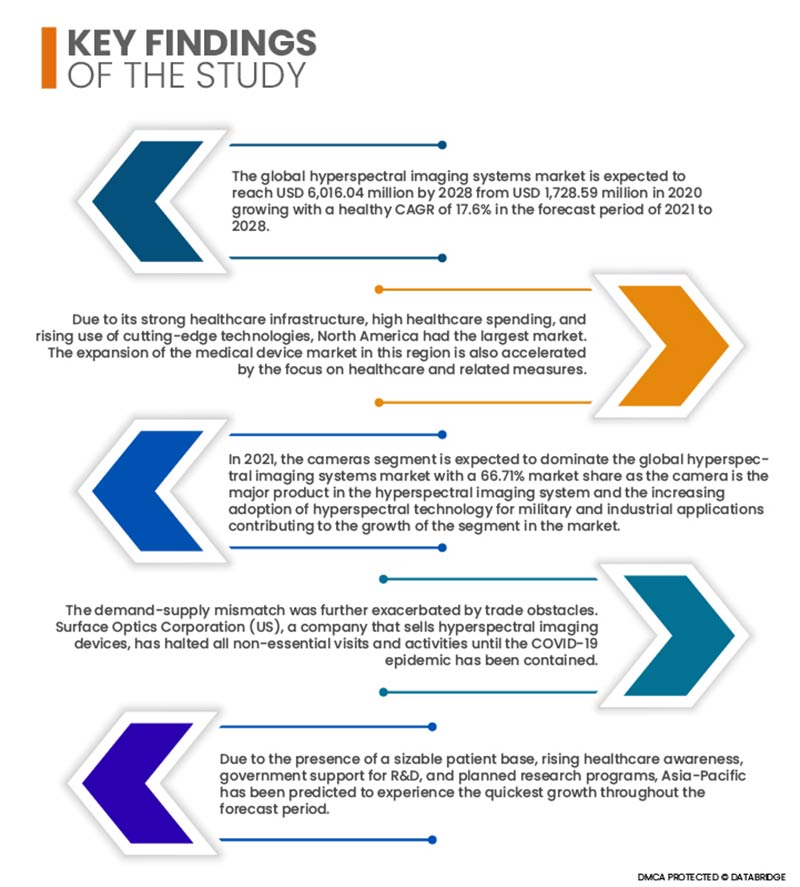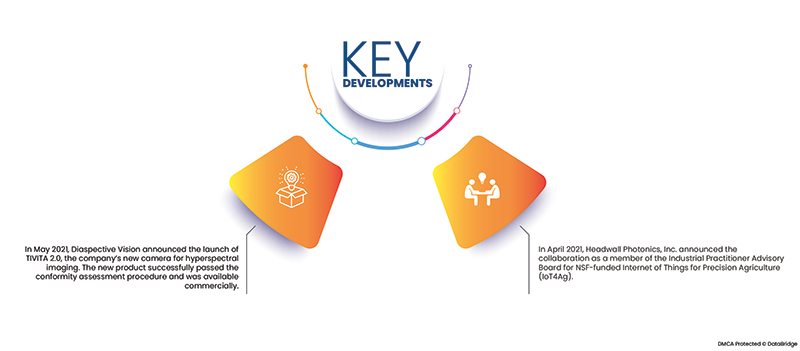2021년 10월, 핀란드에 본사를 둔 우주 기반 초분광 이미징 및 AI 솔루션 제공업체 쿠바 스페이스(Kuva Space)는 상업용 초분광 큐브샛(cubesat) 구축 캠페인을 위해 420만 유로(€420만)를 모금했습니다. 쿠바 스페이스는 이 자금을 통해 400~1,100나노미터 대역의 영상을 수집하는 6대의 큐브샛으로 구성된 위성군을 개발할 계획입니다. 쿠바 스페이스는 생물 다양성과 생태계 파괴 방지를 위해 노력하는 단체들을 지원한다는 목표를 유지하고 있습니다.
세계 초분광 이미징 시스템 시장은 2020년 17억 2,859만 달러에서 2028년 60억 1,604만 달러로 성장할 것으로 예상되며, 2021년부터 2028년까지 17.6%의 안정적인 연평균 성장률(CAGR)을 기록할 것으로 전망됩니다. 초분광 이미징 시스템 시장 성장을 견인하는 주요 요인으로는 초분광 위성 이미징에 대한 정부 투자 증가, 항공 초분광 이미징 솔루션 활용 급증, 그리고 농업 분야에서의 초분광 이미징 활용 증가가 있습니다. 원격 탐사를 위한 초분광 이미징 기술의 급속한 발전은 시장 성장 기회를 창출하고 있습니다.

전 세계적으로 공중 초분광 이미징 솔루션의 활용이 급증함에 따라 시장 성장률이 높아질 것입니다.
초분광 이미징 시스템은 수백 개의 좁고 연속적인 스펙트럼 대역에서 영상을 획득할 수 있어 지구 표면의 다양한 지형을 정밀하게 구분할 수 있습니다. 위성과 같은 이동 플랫폼에 통합될 경우, 초분광 이미징 시스템은 지구 표면에서 방출되는 복사 에너지를 수집할 수 있습니다. 이 기술은 위성이 지상 및 대기 데이터 세트의 고유한 추세를 파악하는 능력을 향상시킵니다. 따라서 화재 예측, 인프라 보호, 정보 강화, 보안 강화, 위험 완화 등 경쟁 우위 확보를 위한 HSI 통합 위성의 다양한 활용은 초분광 이미징 시스템 시장 투자를 촉진할 것으로 예상됩니다.
보고서 범위 및 시장 세분화
보고서 메트릭
|
세부
|
예측 기간
|
2021년부터 2028년까지
|
기준 연도
|
2020
|
역사적인 해
|
2019 (2013~2018년으로 맞춤 설정 가능)
|
양적 단위
|
매출(백만 달러), 볼륨(단위), 가격(달러)
|
다루는 세그먼트
|
제품(카메라 및 액세서리), 스캐닝 기술(공간 스캐닝, 스펙트럼 스캐닝, 비스캐닝 및 공간 스펙트럼 스캐닝), 범위(400Nm 미만, 400Nm~1700Nm 및 1700Nm 초과), 기술(푸시브룸(라인 스캐닝), 스냅샷(단일 샷), 위스크브룸(포인트 스캐닝) 및 기타), 응용 분야(토목 공학, 군사 감시, 원격 감지, 농업, 광업/광물 매핑, 환경 모니터링, 생명 과학 및 의료 진단, 머신 비전 및 광학 분류, 식품 가공, 광물학 및 기타 응용 분야)
|
포함 국가
|
미국, 북미의 캐나다 및 멕시코, 독일, 프랑스, 영국, 네덜란드, 스위스, 벨기에, 러시아, 이탈리아, 스페인, 터키, 유럽의 기타 유럽 국가, 중국, 일본, 인도, 한국, 싱가포르, 말레이시아, 호주, 태국, 인도네시아, 필리핀, 아시아 태평양(APAC)의 기타 아시아 태평양(APAC), 사우디아라비아, UAE, 남아프리카 공화국, 이집트, 이스라엘, 중동 및 아프리카(MEA)의 일부인 기타 중동 및 아프리카(MEA), 남미의 일부인 기타 남미 국가.
|
시장 참여자 포함
|
Imec VZW(벨기에), Corning Incorporated(미국), HORIBA, Ltd(일본), Hamamatsu Photonics KK(일본), Thorlabs, Inc.(미국), BaySpec, Inc.(미국), Brandywine Photonics LLC(미국), ChemImage Corporation(미국), Cubert GmbH(독일), CytoViva, Inc.(미국), Diaspective Vision(독일), Headwall Photonics, Inc.(미국), Hinalea Imaging(미국), HyperMed Imaging, Inc.(미국), Inno-Spec GmbH(독일), LLA Instruments GmbH & Co. KG(독일), Norsk Electro Optik AS(캐나다), Photon Etc. Inc.(노르웨이), Physical Sciences Inc.(미국), Raptor Photonics(영국), Resonon Inc.(미국), SPECIM(핀란드), SPECTRAL IMAGING LTD. (핀란드), STEMMER IMAGING AG(독일), Surface Optics Corporation(미국), Teledyne Digital Imaging Inc.(캐나다), Telops(캐나다), XIMEA Group(독일) 등이 있습니다.
|
보고서에서 다루는 데이터 포인트
|
Data Bridge Market Research 팀이 큐레이팅한 시장 보고서에는 시장 가치, 성장률, 시장 부문, 지리적 범위, 시장 참여자, 시장 시나리오와 같은 시장 통찰력 외에도 심층적인 전문가 분석, 수입/수출 분석, 가격 분석, 생산 소비 분석, 유봉 분석이 포함되어 있습니다.
|
세그먼트 분석:
글로벌 초분광 이미징 시스템 시장은 제품, 스캐닝 기술, 범위, 기술, 속도, 탭 수 및 응용 프로그램을 기준으로 8개의 주요 세그먼트로 구분됩니다.
- 제품 기준으로 글로벌 초분광 이미징 시스템 시장은 카메라와 액세서리로 구분됩니다. 2021년에는 카메라 부문이 66.71%의 시장 점유율을 기록하며 글로벌 초분광 이미징 시스템 시장을 주도할 것으로 예상됩니다. 카메라가 초분광 이미징 시스템의 주요 제품이며, 군사 및 산업 분야에서 초분광 기술 도입이 증가함에 따라 초분광 이미징 시스템 부문의 성장이 가속화될 것으로 예상됩니다.
- 스캐닝 기술을 기준으로 전 세계 초분광 이미징 시스템 시장은 공간 스캐닝, 스펙트럼 스캐닝, 비스캐닝, 그리고 공간 스펙트럼 스캐닝으로 구분됩니다. 2021년에는 공간 스캐닝 부문이 43.74%의 시장 점유율을 기록하며 시장을 장악할 것으로 예상됩니다. 공간 스캐닝은 초분광 데이터 수집에 사용되는 주요 방법 중 하나이며 광범위한 스펙트럼에서 높은 스펙트럼 해상도를 제공하기 때문입니다. 공간 스캐닝은 초분광 스캐닝의 주요 사용 분야이며, 이는 해당 부문의 도입 및 성장을 촉진합니다.
- 전 세계 초분광 이미징 시스템 시장은 파장 범위를 기준으로 400nm 미만, 400nm~1700nm, 그리고 1700nm 이상으로 세분화되었습니다. 2021년에는 400nm~1700nm 영역이 53.10%의 시장 점유율을 기록하며 시장을 주도할 것으로 예상됩니다. 400nm~1700nm 영역은 식품 오염 물질 검출, 의료 진단, 군사 감시, 플라스틱 재활용 등의 분야에서 초분광 이미징에 가장 널리 사용되는 영역이기 때문입니다.
- 기술 측면에서 볼 때, 글로벌 초분광 이미징 시스템 시장은 푸시브룸(라인 스캐닝), 스냅샷(단일 촬영), 위스크브룸(포인트 스캐닝) 등으로 세분화되었습니다. 2021년에는 푸시브룸(라인 스캐닝)이 40.07%의 시장 점유율로 시장을 장악할 것으로 예상됩니다. 푸시브룸 기술은 다른 어떤 기술보다 빠르고, 더 많은 빛을 수집하며, 더 우수한 방사 및 공간 분해능을 가지고 있으며, 가장 널리 사용되는 초분광 이미징 방식이기 때문입니다. 이러한 특징으로 인해 초분광 이미징 시스템 시장에서 푸시브룸 기술의 도입이 가속화되고 있습니다.
푸시브룸(라인 스캐닝)은 기능성 버섯 시장의 기술 부문을 지배할 것입니다.
푸시브룸(라인 스캐닝)은 2021년 약 40%의 시장 점유율을 기록하며 기술 분야에서 지배적인 부문으로 부상할 것입니다. 이는 특히 개발도상국에서 인프라 개발 활동과 매장 기반 소매업체의 증가에 기인합니다. 또한, 전 세계적으로 반도체 산업의 성장과 확장은 이 부문의 성장을 더욱 가속화할 것입니다.
- 응용 분야별로 볼 때, 글로벌 초분광 이미징 시스템 시장은 원격 감지, 군사 감시, 머신 비전 및 광학 분류, 생명 과학 및 의료 진단, 농업, 식품 가공, 환경 모니터링 , 광업/광물 매핑, 광물학, 토목 공학 및 기타 분야로 세분화되었습니다. 이러한 모든 분야는 제품별로 카메라 및 액세서리로 세분화됩니다. 2021년에는 원격 감지가 농업, 광물 탐사, 환경 모니터링 등 다양한 원격 감지 분야에서 초분광 이미징 시장 점유율 20.0%를 차지하며 시장을 주도할 것으로 예상됩니다. 초분광 이미징 분야에서 원격 감지는 인간의 눈으로는 볼 수 없는 영역의 문제를 해결합니다.
원격 감지 부문은 기능성 버섯 시장의 응용 부문을 지배할 것입니다.
원격 감지 분야는 2021년 응용 분야에서 가장 큰 비중을 차지하는 분야로 부상할 것입니다. 이는 특히 개발도상국 시장에서 초분광 이미징 시스템의 다양한 연구 목적 적용 분야를 위한 시료 채취 절차가 증가하고 있기 때문입니다. 또한, 전 세계적으로 연구 개발 서비스가 성장하고 확대됨에 따라 이 분야의 성장은 더욱 가속화될 것입니다.
- 속도를 기준으로 글로벌 초분광 이미징 시스템 시장은 최대 20MHz, 20MHz~40MHz, 40MHz 이상으로 구분됩니다.
- 탭 수를 기준으로 글로벌 초분광 이미징 시스템 시장은 1탭과 2탭으로 구분됩니다.
주요 플레이어
Data Bridge Market Research는 다음 회사를 초분광 이미징 시스템 시장의 시장 주체로 인식합니다: Imec VZW(벨기에), Corning Incorporated(미국), HORIBA, Ltd(일본), Hamamatsu Photonics KK(일본), Thorlabs, Inc.(미국), BaySpec, Inc.(미국), Brandywine Photonics LLC(미국), ChemImage Corporation(미국), Cubert GmbH(독일), CytoViva, Inc.(미국), Diaspective Vision(독일), Headwall Photonics, Inc.(미국), Hinalea Imaging(미국), STEMMER IMAGING AG(독일), Surface Optics Corporation(미국), Teledyne Digital Imaging Inc.(캐나다), Telops(캐나다) 및 XIMEA Group(독일).

시장 개발
- 2021년 5월, Diaspective Vision은 초분광 이미징을 위한 새로운 카메라인 TIVITA 2.0 출시를 발표했습니다. 이 신제품은 적합성 평가 절차를 성공적으로 통과하여 시판되었습니다. 이 신제품은 오염 위험 없이 비접촉 및 비침습적 이미징이 가능하며, 전리 방사선과 조영제가 전혀 필요하지 않습니다.
- 2021년 4월, Headwall Photonics, Inc.는 NSF가 지원하는 정밀 농업을 위한 사물 인터넷(IoT4Ag) 산업 실무자 자문 위원회(Industry Practitioner Advisory Board) 회원으로서 협력을 발표했습니다. NSF 공학 연구 센터(NSF Engineering Research Center) 직원들은 Headwall의 초분광 센서를 무인 항공기(UAV) 시스템에 통합하여 식물 생리, 토양 특성, 관리 및 환경 변화를 포착하고 분석하는 데이터 기반 모델을 구축했습니다. 이를 통해 농업 기술 분야에서 Headwall의 입지가 더욱 강화되었습니다.
지역 분석
지리적으로 초분광 이미징 시스템 시장 보고서에서 다루는 국가는 북미의 미국, 캐나다 및 멕시코, 유럽의 독일, 프랑스, 영국, 네덜란드, 스위스, 벨기에, 러시아, 이탈리아, 스페인, 터키, 유럽의 기타 유럽, 중국, 일본, 인도, 한국, 싱가포르, 말레이시아, 호주, 태국, 인도네시아, 필리핀, 아시아 태평양(APAC)의 기타 아시아 태평양(APAC), 사우디 아라비아, UAE, 남아프리카 공화국, 이집트, 이스라엘, 중동 및 아프리카(MEA)의 일부인 기타 중동 및 아프리카(MEA), 남미의 일부인 기타 남미, 브라질, 아르헨티나입니다.
Data Bridge Market Research 분석에 따르면:
북미는 2021년부터 2028년까지의 예측 기간 동안 초분광 이미징 시스템 시장 에서 지배적인 지역입니다.
북미 지역은 탄탄한 의료 인프라, 높은 의료비 지출, 그리고 최첨단 기술 사용 증가로 인해 가장 큰 시장 점유율을 기록했습니다. Research America의 자료에 따르면, 미국은 의료 및 헬스케어 R&D에 약 1,718억 달러를 지출했습니다. 환자보호 및 부담적정보험법(PAA)과 같은 헬스케어 및 관련 조치에 대한 집중으로 인해 이 지역의 의료기기 시장 확대는 가속화되고 있습니다. 이러한 요인은 곧 시장에 긍정적인 영향을 미칠 것으로 예상됩니다.
아시아 태평양 지역은 2021년부터 2028년까지 초분광 이미징 시스템 시장 에서 가장 빠르게 성장하는 지역으로 추정됩니다.
아시아 태평양 지역은 상당한 환자 기반, 의료 인식 제고, 정부의 R&D 지원, 그리고 계획된 연구 프로그램 덕분에 예측 기간 동안 가장 빠른 성장을 경험할 것으로 예상됩니다. 연구 프로젝트, 원격 감지 응용 프로그램, 그리고 광산 탐사에서 초분광 이미징의 필요성이 더욱 커질 것으로 예상됩니다.
COVID-19 영향
COVID-19 발발은 전 세계의 무역과 경제 활동에 영향을 미쳤습니다. 초분광 이미징 시스템 시장은 이번 팬데믹으로 인해 단기적인 영향을 받을 것으로 예상됩니다. 전 세계 여러 국가가 광범위한 봉쇄령을 선포하고 다양한 사업체의 일시적인 폐쇄를 시행하면서 생산 및 제조 부문이 상당한 타격을 입었습니다. 무역 장벽은 수요와 공급의 불균형을 더욱 심화시켰습니다. 초분광 이미징 장치를 판매하는 Surface Optics Corporation(미국)은 COVID-19 팬데믹이 종식될 때까지 모든 비필수적인 방문 및 활동을 중단했습니다. 그럼에도 불구하고 이러한 사업체 중 상당수는 여전히 원격으로 운영되고 있습니다. 의료, 식품, 농업, 국방과 같은 주요 분야에서는 이미 생산 및 제조가 시작되었습니다.
초분광 이미징 시스템 시장 보고서 에 대한 자세한 내용은 여기를 클릭하세요 - https://www.databridgemarketresearch.com/reports/global-hyperspectral-imaging-systems-market










